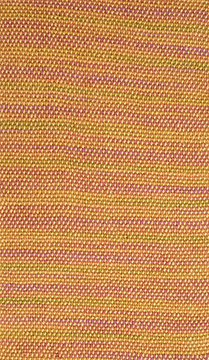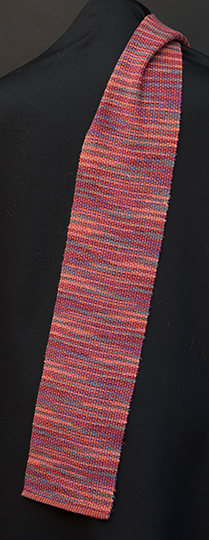Using Variegated Yarn for Weft
Marcy Petrini
June 2019
Some of the same principles that we discussed last month in using a variegated yarn for warp apply to using a variegated yarn for weft, if we want to make the pattern more visible: a bold pattern, not much contrast in the colors of the variegated yarn, but more contract between warp and weft colors; the distance at which we want the pattern visible is also important.
There are some differences, however: in the warp, the color repeats of the yarn are generally more spread out, because of the length. When used as a weft, how the colors of the variegated yarn are organized depends on the width of the piece, which is usually not the same as the length of the warp. So colors in the weft can stripe, pool or look more random, depending on the relationship of the color repeats with the width of the piece.
Also, think about how we wind our bobbins or shuttles: first of all, chances are that we won’t wind exactly the same yardage on each bobbin; but more important, we can start winding at the beginning of a ball or cone, say point A, and wind to point B, which is where out weaving begins; for the next winding, we will start at point B and end at point C, which is where the weaving begins, so the colors will no longer be in order; for the weft in the fabric we have: B to A, C to B, etc.
Of course, if we really wanted, we could carefully rewind balls and match to keep the colors in order, but that is a bit tedious.
Below is the pictures of two scarves both woven with a ribbed twill using two yarns, Reno Sunrise which is variegated and cinnamon which is solid. On the left, the warp is solid, the weft is variegated; on the right, the warp is variegated, the weft is solid. From a distance, the scarf with the variegated warp is more interesting. There is some cinnamon in the variegated yarn, which blends with the weft, resulting in the other colors being more prominent.

The close ups of the scarves are below, first the variegated weft, then the variegated warp. Close up the ribs are more visible with the variegated weft, while the twill line is more visible in the variegated warp. Which is better? Totally a matter of personal preference.


When using a variegated yarn for weft, I often want to showcase the colors, rather than the pattern. I use these possible combinations, often, but not always, in plain weave:
- solid warp, variegated weft;
- different solid warp colors, variegated weft;
- striped warp and variegated weft;
- both warp and weft variegated;
- both warp and weft variegated, but different yarns.
Below is a close up of a scarf with a gold silk warp and a variegated cotton weft, woven on my rigid heddle loom. I like the way the colors migrate across the width, almost like a watercolor painting.

The scarf below has three yarns for warp: rust, peach and purple, all solids 5/2 cotton; the weft is a variegated rayon weft with the same colors plus some green; It was woven in plain weave. I like the way the colors pool.

Three broad stripes in chestnut, cheddar and cranberry make up the warp of the scarf below. The weft is a variegated yarn called sugar maple with golds, greens, reds and browns. It was woven as a broken twill.

Note how the different colors of the weft disappear in the warp stripes, depending on its colors, shown in the close up below. This is a good strategy when wanting to showcase certain colors.

Compare the two scarves below, both woven in plain weave. The one on the left has three solid warp threads in blue, aqua blue and red purple with a variegated rayon weft of the same colors plus a bright green. The same rayon is used for warp and weft in the scarf on the right. The variegated weft results in irregular stripes on the left, and the interaction between warp and weft forms a crazy plaid on the right.

This scarf has a variegated Tencel warp in blues, greens and purples, and a variegated silk weft of blues; the variegated weft accentuates the blues of the variegated warp. The advancing twill causes a textured appearance from a distance.

What color interactions do you like for your variegated yarns?
Happy weaving!
Please email comments and questions to
